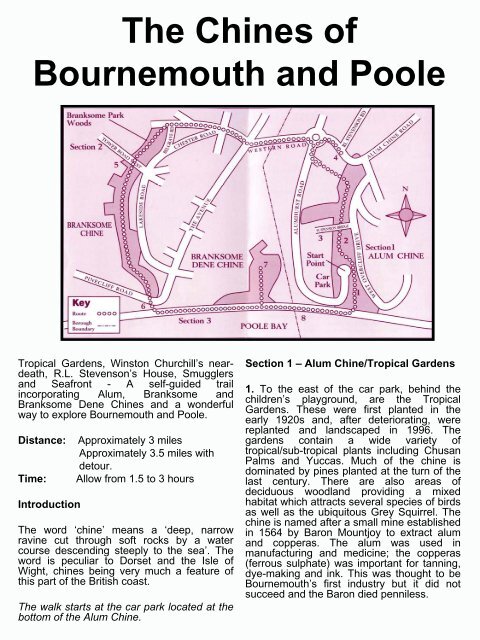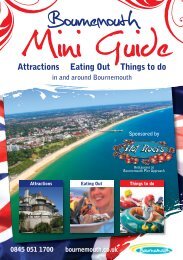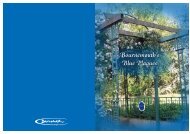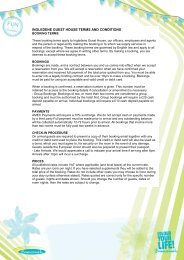The Chines of Bournemouth and Poole
The Chines of Bournemouth and Poole
The Chines of Bournemouth and Poole
You also want an ePaper? Increase the reach of your titles
YUMPU automatically turns print PDFs into web optimized ePapers that Google loves.
<strong>The</strong> <strong>Chines</strong> <strong>of</strong><br />
<strong>Bournemouth</strong> <strong>and</strong> <strong>Poole</strong><br />
Tropical Gardens, Winston Churchill’s neardeath,<br />
R.L. Stevenson’s House, Smugglers<br />
<strong>and</strong> Seafront - A self-guided trail<br />
incorporating Alum, Branksome <strong>and</strong><br />
Branksome Dene <strong>Chines</strong> <strong>and</strong> a wonderful<br />
way to explore <strong>Bournemouth</strong> <strong>and</strong> <strong>Poole</strong>.<br />
Distance:<br />
Time:<br />
Introduction<br />
Approximately 3 miles<br />
Approximately 3.5 miles with<br />
detour.<br />
Allow from 1.5 to 3 hours<br />
<strong>The</strong> word ‘chine’ means a ‘deep, narrow<br />
ravine cut through s<strong>of</strong>t rocks by a water<br />
course descending steeply to the sea’. <strong>The</strong><br />
word is peculiar to Dorset <strong>and</strong> the Isle <strong>of</strong><br />
Wight, chines being very much a feature <strong>of</strong><br />
this part <strong>of</strong> the British coast.<br />
<strong>The</strong> walk starts at the car park located at the<br />
bottom <strong>of</strong> the Alum Chine.<br />
Section 1 – Alum Chine/Tropical Gardens<br />
1. To the east <strong>of</strong> the car park, behind the<br />
children’s playground, are the Tropical<br />
Gardens. <strong>The</strong>se were first planted in the<br />
early 1920s <strong>and</strong>, after deteriorating, were<br />
replanted <strong>and</strong> l<strong>and</strong>scaped in 1996. <strong>The</strong><br />
gardens contain a wide variety <strong>of</strong><br />
tropical/sub-tropical plants including Chusan<br />
Palms <strong>and</strong> Yuccas. Much <strong>of</strong> the chine is<br />
dominated by pines planted at the turn <strong>of</strong> the<br />
last century. <strong>The</strong>re are also areas <strong>of</strong><br />
deciduous woodl<strong>and</strong> providing a mixed<br />
habitat which attracts several species <strong>of</strong> birds<br />
as well as the ubiquitous Grey Squirrel. <strong>The</strong><br />
chine is named after a small mine established<br />
in 1564 by Baron Mountjoy to extract alum<br />
<strong>and</strong> copperas. <strong>The</strong> alum was used in<br />
manufacturing <strong>and</strong> medicine; the copperas<br />
(ferrous sulphate) was important for tanning,<br />
dye-making <strong>and</strong> ink. This was thought to be<br />
<strong>Bournemouth</strong>’s first industry but it did not<br />
succeed <strong>and</strong> the Baron died penniless.
2. One slope just before the Suspension<br />
Bridge has been cleared <strong>and</strong> thous<strong>and</strong>s<br />
<strong>of</strong> heather plugs have been planted by<br />
conservation <strong>of</strong>ficers <strong>and</strong> pupils from<br />
Portchester Boys School between 1994<br />
<strong>and</strong> 1999. Heathl<strong>and</strong> is being<br />
successfully re-established to restore<br />
this once more widespread wildlife<br />
habitat.<br />
3. <strong>The</strong> suspension bridge was built in<br />
1903/04 by David Rowell & Co. <strong>and</strong> cost<br />
£480! Some local historians believe this<br />
to be the bridge from which Winston<br />
Churchill fell in 1892. <strong>The</strong> 18-year-old<br />
Churchill, staying locally, was being<br />
chased by his younger brother <strong>and</strong><br />
cousin in Alum (or possibly even<br />
Branksome Dene) Chine when he tried<br />
to jump from a bridge to an adjacent fir<br />
tree. He lost his grip <strong>and</strong> fell 30 feet to<br />
the ground below. He was unconscious<br />
for three days <strong>and</strong> bed bound for three<br />
months. History could have been<br />
dramatically different if he had not been<br />
so lucky.<br />
A plaque between the two bridges near<br />
the top <strong>of</strong> Alum Chine commemorates<br />
Robert Louis Stevenson.<br />
To get to the site <strong>of</strong> his house, follow the<br />
arrow out onto Warren Road. Turn right<br />
into Alumhurst Road. At the roundabout<br />
turn right into Alum Chine Road. <strong>The</strong> site<br />
<strong>of</strong> the house is a short way along on the<br />
right, opposite R.L. Stevenson Avenue.<br />
4. Stevenson came to <strong>Bournemouth</strong> as a<br />
TB sufferer in 1884. <strong>The</strong> house was<br />
formerly called ‘Sea View’ before he<br />
renamed it ‘Skerryvore’ after a<br />
lighthouse built by his family’s company.<br />
<strong>The</strong> position <strong>of</strong> the house is marked by a<br />
low wall <strong>and</strong> there is a model <strong>of</strong> the<br />
lighthouse. You will find more<br />
information on display in the garden.<br />
Retrace your steps back along Alum<br />
Chine Road to the roundabout. Proceed<br />
along the Western Road, crossing <strong>The</strong><br />
Avenue at a safe place. Continue along<br />
Western Road until you come to<br />
Belgrave Road.<br />
Enter Branksome Park Woods via the<br />
access point adjacent to Belgrave Road.<br />
Follow the main path through the woods,<br />
then cross Tower Road West <strong>and</strong> enter<br />
Branksome Chine. Follow the markers<br />
down through the chine.<br />
Section 2 – Branksome Chine<br />
5. In the 18th Century, Branksome Chine is<br />
said to have been a regular route for<br />
smugglers as they headed inl<strong>and</strong> to the<br />
Kinson area. Like Alum Chine, it also has a<br />
link with a great literary character. John<br />
Betjeman, former Poet Laureate, once<br />
wrote – ‘walk the asphalt paths <strong>of</strong><br />
Branksome Chine/In resin scented air like<br />
strong Greek wine’.<br />
<strong>The</strong> chine has numerous tree species such<br />
as pines, maples <strong>and</strong> beech as well as a<br />
variety <strong>of</strong> shrubs. Birds can be seen<br />
throughout the year including Jays,<br />
woodpeckers, thrushes, tits <strong>and</strong> summer<br />
warblers. During the summer months,<br />
many insects can be seen including<br />
butterflies <strong>and</strong> dragonflies, the latter being<br />
attracted by the stream.<br />
6. In 1932 a solarium opened in one <strong>of</strong> the<br />
buildings where the café is situated at the<br />
southern end <strong>of</strong> the chine. It was only one<br />
<strong>of</strong> its kinds in Britain at the time <strong>and</strong> <strong>of</strong>fered<br />
‘sunshine’ all year round. <strong>The</strong> ‘sunbathing’<br />
took place under ultra-violet lamps <strong>and</strong><br />
drinks were served by waitresses. <strong>The</strong><br />
lamps gave light <strong>and</strong> heat producing the<br />
same effect as warm sunshine. <strong>The</strong> rays<br />
were believed to have beneficial effects –<br />
destroying germs, providing resistance to<br />
disease <strong>and</strong> stimulating the nervous<br />
system.<br />
Section 3 – Seafront/Branksome Dene<br />
Chine<br />
7. In the 1850s, the lower part <strong>of</strong> the<br />
Branksome Dene Chine was owned by Mr.<br />
Charles Packe, an MP for South<br />
Leicestershire. He built a mansion on the<br />
cliffs <strong>and</strong> called Branksome Tower, which<br />
is no longer st<strong>and</strong>ing.
<strong>The</strong> Packe family also had a mausoleum<br />
built on the edge <strong>of</strong> Branksome Dene<br />
Chine, designed by William Burn, which<br />
contains the bodies <strong>of</strong> Charles Packe <strong>and</strong><br />
his wife. <strong>The</strong> mausoleum was restored by<br />
the Borough <strong>of</strong> <strong>Poole</strong> in 1993. <strong>The</strong>re is an<br />
optional detour from the route to see the<br />
building, which would take about a half to<br />
three quarters <strong>of</strong> an hour. <strong>The</strong> walk is<br />
uphill but good views can be enjoyed in<br />
fine weather.<br />
NB – the mausoleum is usually open<br />
at the end <strong>of</strong> April, June <strong>and</strong><br />
September.<br />
To get to the mausoleum, turn left by the<br />
ice cream kiosk. Go up two flights <strong>of</strong><br />
steps between the white beach huts, then<br />
up a third flight <strong>of</strong> steps <strong>and</strong> then follow<br />
the yellow arrow markers until you come<br />
out onto the road. <strong>The</strong> mausoleum is at<br />
the top <strong>of</strong> the hill.<br />
Be aware <strong>of</strong> traffic when walking along<br />
the road.<br />
Retrace yours steps to the seafront to<br />
continue the route.<br />
8. <strong>The</strong>re are some interesting geological<br />
features to be seen as you walk back<br />
towards Alum Chine. Immediately east <strong>of</strong><br />
the Branksome Dene Chine, a low cliff<br />
section has laminated pink <strong>and</strong> grey<br />
cross-bedded silts, s<strong>and</strong>s <strong>and</strong> clays.<br />
B<strong>and</strong>s <strong>of</strong> sediment called Varves, left<br />
behind by water, can also be seen here.<br />
<strong>The</strong>y consist <strong>of</strong> light <strong>and</strong> dark layers<br />
deposited at different seasons. In the<br />
higher cliff faces, yellow <strong>and</strong> orange<br />
layers <strong>of</strong> s<strong>and</strong> are noticeable. <strong>The</strong>se are<br />
successive layers <strong>of</strong> fluvial sediments<br />
indicating the position <strong>of</strong> a former river<br />
valley.<br />
On clear days there are fine views along<br />
the coast. Look for Old Harry’s Rock to<br />
the west, <strong>and</strong> Hengistbury Head <strong>and</strong> the<br />
Isle <strong>of</strong> Wight to the east. On the<br />
beaches, watch for the various species<br />
<strong>of</strong> gulls <strong>and</strong> terns as well as the black<br />
<strong>and</strong> white Oystercatcher.<br />
Continue along the seafront until you<br />
reach the south end <strong>of</strong> Alum Chine <strong>and</strong><br />
the car park where the route began.<br />
Further Information<br />
Parking: Pay <strong>and</strong> display parking is<br />
available at the bottom <strong>of</strong> Alum Chine.<br />
<strong>The</strong>re is also parking available at the end<br />
<strong>of</strong> Branksome Chine by the café if you<br />
wish to start the walk from there.<br />
Buses: For bus service information<br />
regarding any part <strong>of</strong> this route, the<br />
following numbers will be <strong>of</strong> use;<br />
Yellow Buses 0871 200 2233<br />
Wilts <strong>and</strong> Dorset 01202 673 555<br />
Terrain: Surfaced footpaths for most <strong>of</strong><br />
the route. <strong>The</strong>re are some uneven<br />
footpaths with tree roots in places. <strong>The</strong><br />
walk through Alum Chine is uphill. <strong>The</strong>re<br />
are several flights <strong>of</strong> steps on the route<br />
although most <strong>of</strong> these are encountered<br />
on the optional detour to the mausoleum.<br />
<strong>The</strong> middle section <strong>of</strong> the route includes<br />
pavements. Please take care when<br />
crossing busy roads.<br />
For further information on activities<br />
<strong>and</strong> walks in <strong>Bournemouth</strong> visit<br />
www.bournemouth.co.uk or call 0845<br />
051 1700.
















